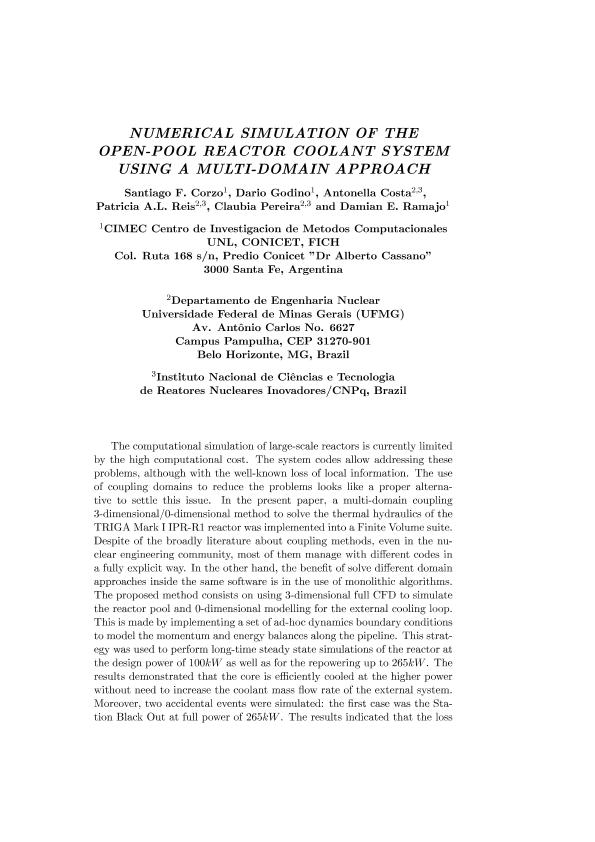Mostrar el registro sencillo del ítem
dc.contributor.author
Corzo, Santiago Francisco

dc.contributor.author
Godino, Dario Martin

dc.contributor.author
Costa, Antonella Lombardi

dc.contributor.author
Reis, Patricia A. L.
dc.contributor.author
Pereira, Claubia
dc.contributor.author
Ramajo, Damian Enrique

dc.date.available
2021-09-07T13:26:42Z
dc.date.issued
2020-08
dc.identifier.citation
Corzo, Santiago Francisco; Godino, Dario Martin; Costa, Antonella Lombardi; Reis, Patricia A. L.; Pereira, Claubia; et al.; Numerical simulation of the open-pool reactor coolant system using a multi-domain approach; Elsevier Science SA; Nuclear Engineering and Design; 368; 8-2020; 110739
dc.identifier.issn
0029-5493
dc.identifier.uri
http://hdl.handle.net/11336/139783
dc.description.abstract
The computational simulation of large-scale reactors is currently limited by the high computational cost. The system codes allow addressing these problems, although with the well-known loss of local information. The use of coupling domains to reduce the problems looks like a proper alternative to settle this issue. In the present paper, a multi-domain coupling 3-dimensional/0-dimensional method to solve the thermal hydraulics of the TRIGA Mark I IPR-R1 reactor was implemented into a Finite Volume suite. Despite of the broadly literature about coupling methods, even in the nuclear engineering community, most of them manage with different codes in a fully explicit way. In the other hand, the benefit of solve different domain approaches inside the same software is in the use of monolithic algorithms. The proposed method consists on using 3-dimensional full CFD to simulate the reactor pool and 0-dimensional modelling for the external cooling loop. This is made by implementing a set of ad hoc dynamics boundary conditions to model the momentum and energy balances along the pipeline. This strategy was used to perform long-time steady state simulations of the reactor at the design power of 100 kW as well as for the repowering up to 265 kW. The results demonstrated that the core is efficiently cooled at the higher power without need to increase the coolant mass flow rate of the external system. Moreover, two accidental events were simulated: the first case was the Station Black Out at full power of 265 kW. The results indicated that the loss of the external heat sink led to a slow pool heating, but the core remains being cooled by the natural circulation in the pool. In fact, the mass flow rate through the core is only reduced in 15% by the loss of the external loop circulation. Finally, a large-Loss of Coolant Accident for the operational power of 100 kW and keeping the pump running is performed. In this case, the pool is quickly empty if safety systems do not take action and the core is uncovered after 450 s completely losing the core cooling capacity.
dc.format
application/pdf
dc.language.iso
eng
dc.publisher
Elsevier Science SA

dc.rights
info:eu-repo/semantics/openAccess
dc.rights.uri
https://creativecommons.org/licenses/by-nc-nd/2.5/ar/
dc.subject
CFD
dc.subject
TRIGA REACTOR
dc.subject
3D/0D COUPLING
dc.subject
NUCLEAR SAFETY ASSESSMENT
dc.subject
OPENFOAM
dc.subject.classification
Ingeniería Nuclear

dc.subject.classification
Ingeniería Mecánica

dc.subject.classification
INGENIERÍAS Y TECNOLOGÍAS

dc.title
Numerical simulation of the open-pool reactor coolant system using a multi-domain approach
dc.type
info:eu-repo/semantics/article
dc.type
info:ar-repo/semantics/artículo
dc.type
info:eu-repo/semantics/publishedVersion
dc.date.updated
2021-03-15T14:36:09Z
dc.journal.volume
368
dc.journal.pagination
110739
dc.journal.pais
Países Bajos

dc.journal.ciudad
Amsterdam
dc.description.fil
Fil: Corzo, Santiago Francisco. Consejo Nacional de Investigaciones Científicas y Técnicas. Centro Científico Tecnológico Conicet - Santa Fe. Centro de Investigaciones en Métodos Computacionales. Universidad Nacional del Litoral. Centro de Investigaciones en Métodos Computacionales; Argentina
dc.description.fil
Fil: Godino, Dario Martin. Consejo Nacional de Investigaciones Científicas y Técnicas. Centro Científico Tecnológico Conicet - Santa Fe. Centro de Investigaciones en Métodos Computacionales. Universidad Nacional del Litoral. Centro de Investigaciones en Métodos Computacionales; Argentina
dc.description.fil
Fil: Costa, Antonella Lombardi. Universidade Federal de Minas Gerais; Brasil. Conselho Nacional de Desenvolvimiento Científico e Tecnológico; Brasil
dc.description.fil
Fil: Reis, Patricia A. L.. Universidade Federal de Minas Gerais; Brasil. Conselho Nacional de Desenvolvimiento Científico e Tecnológico; Brasil
dc.description.fil
Fil: Pereira, Claubia. Universidade Federal de Minas Gerais; Brasil. Conselho Nacional de Desenvolvimiento Científico e Tecnológico; Brasil
dc.description.fil
Fil: Ramajo, Damian Enrique. Consejo Nacional de Investigaciones Científicas y Técnicas. Centro Científico Tecnológico Conicet - Santa Fe. Centro de Investigaciones en Métodos Computacionales. Universidad Nacional del Litoral. Centro de Investigaciones en Métodos Computacionales; Argentina
dc.journal.title
Nuclear Engineering and Design

dc.relation.alternativeid
info:eu-repo/semantics/altIdentifier/doi/https://doi.org/10.1016/j.nucengdes.2020.110739
dc.relation.alternativeid
info:eu-repo/semantics/altIdentifier/url/https://www.sciencedirect.com/science/article/abs/pii/S0029549320302338
Archivos asociados
